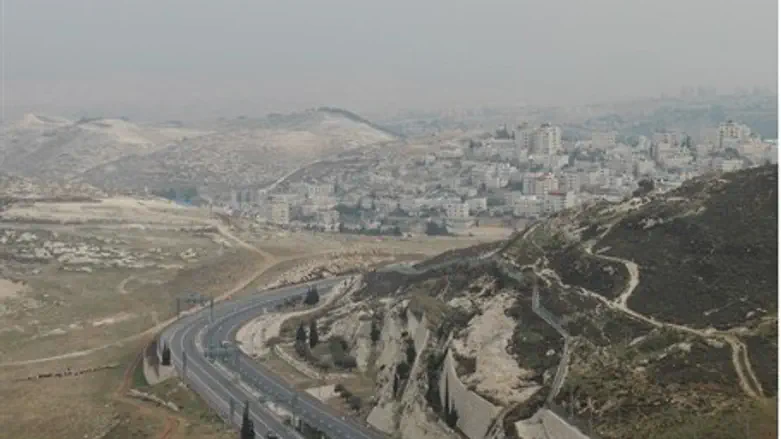
Foreign media and international leaders have condemned Israel for building on “E-1,” but many of the “facts” they quote are fiction. A three-year-old study by Nadav Shragai of the Jerusalem Center of Public Affairs sets the record straight.
“E-1,” which probably would have been more accepted had it borne a more inviting name such as “Sleeping Valley,” is part of – and not next to – the city of Maaleh Adumim, home to more than 40,000 Jews. The international community, foreign media and Peace Now call Maaleh Adumim a “settlement,” conjuring up an image of a few dozen youth with pistols on their hips setting up a fort in the Wild West.
Why Did Prime Minister Binyamin Netanyahu choose to build in E-1?
Actually, it was not his own idea. Shragai points out, as Netanyahu did in the press conference he held for foreign media on Monday, “Every Israeli prime minister since Yitzhak Rabin has supported the plan.”
Foreign media have shown illustrative pictures of Bedouin grazing their sheep, with captions stating that building will force them out. In fact, the E-1 site covers an area of largely uninhabited, state-owned land. Foreign media rarely go out to Judea and Samaria on their own and often rely on photographs from Palestinian Arab photographers.
Foreign leaders and media allege that building on E-1 will prevent a contiguous future Palestinian Authority from Samaria to the southern Hevron Hills.
However, the other side of the coin is that, as Shragai writes, “Without control of the E-1 area, Israel is apprehensive about a Palestinian belt of construction that will threaten Jerusalem from the east, block the city’s development eastward, and undermine Israel’s control of the Jerusalem-Jericho road. This major artery is of paramount strategic importance for Israel in order to transport troops and equipment eastward and northward via the Jordan Rift Valley in time of war.” Without control of the E-1 area, Maaleh Adumim would be cut off from Jerusalem.
Is it true that building on E-1 would cut off Palestinian Authority Arabs in Samaria from areas south of Jerusalem?
That is what media have reported, but The New York Times, nine days after incorrectly stating so, issued a correction: “Because of an editing error, an article last Saturday about Israel’s decision to move forward with planning and zoning for settlements in an area east of Jerusalem known as E-1 described imprecisely the effect of such development on access to the cities of Ramallah and Bethlehem from Jerusalem.
“While development of E-1 would limit access to Ramallah and Bethlehem to narrow corridors far from the Old City and downtown Jerusalem, it would not completely separate those cities from Jerusalem.”
The correction was not complete. Shragai wrote three years ago that not only is it untrue that the completion of E-1 would cut the Ramallah-based Palestinian Authority in half, “Israel has also planned a new road that would allow Palestinian traffic coming from the south to pass eastward of Maaleh Adumim and continue northward to connect with the cities in the northern West Bank."
No less important, “This Palestinian bypass road would actually reduce the time for Palestinian drivers traveling in a north-south direction who would encounter no Israeli roadblocks.”
A Jewish presence in Judea and Samaria, as well as in many areas of Jerusalem, is assumed by foreign media to be illegal because that is what the U.S. State Dept has determined for years. The claim is based on arguments that Israel “occupied” the land, most of which actually was occupied - by Jordan - without a United Nations mandate before seven Arab countries failed in their attempt to annihilate Israel in the Six-Day War in 1967.
Since then, Israel has turned a blind eye to most building by Arabs even though much of the construction violates all accepted building standards and often takes place up to the shoulders of main highways.
In addition, the Oslo Accords do not state that Israel cannot build homes for Jews in Judea and Samaria, contrary to the assumptions of mainstream media and the United Nations.
“Israeli and Palestinian construction in the West Bank has been governed by the legal terms of the Oslo II Interim Agreement from September 28, 1995,” Shragai wrote. “The area around E-1 is within Area C, where, according to Oslo II, Israel retained the powers of zoning and planning. As a result, much of the recently completed Palestinian construction there is illegal. In contrast, none of the Oslo Agreements prohibited Israeli settlement activity, though Israel undertook unilateral limitations upon itself in this area in recent years.
“Israeli construction of E-1 will not undermine Palestinian contiguity, but were Israel to lose control of E-1, the contiguity of Israel would be severely compromised.”
Plans for building on E-1 were approved more than 15 years ago but never were advanced. In the meantime, Bedouin tribes have squatted on much of the land and narrowed the amount available for building.
“During the government of Yitzhak Shamir in 1991, Defense Minister Moshe Arens signed an order transferring part of the area currently known as E-1 to the Maaleh Adumim local authority,” according to Shagrai's research.
“In January 1994, the Higher Planning Council of Judea and Samaria’s Subcommittee for Settlement tabled a new plan that expanded the municipal plan for Maaleh Adumim and, in effect, constituted the basis for the future E-1 plan on an area of 12,000 dunam. (A dunam is 1000sq. meters and is approximately one fifth of an acre).
“Prime Minister Yitzhak Rabin instructed Housing Minister Binyamin Ben Eliezer to begin planning a neighborhood at the location. From then on, planning and authorization procedures for the E-1 neighborhood were promoted but were never totally completed, given the diplomatic constraints.”
He added that the commercial and industrial areas intended for E-1 would serve Arabs as well as Jews and would provide them thousands of jobs.